Abstract
1. The interphalangeal joint of the thumb was driven through sinusoidal flexion-extension movements while electromyograms were recorded from over the flexor pollicis longus muscle. 2. When the subject relaxed his thumb the movement generated no detectable e.m.g. response. When, however, he exerted a voluntary flexing force electrical activity could be recorded from the flexor pollicis longus, the amplitude of which was modulated at the frequency of the movement. 3. As the driving frequency was increased, the maximal e.m.g. activity occurred progressively later in the cycle of movement; for frequencies above about 6 Hz the timing of the averaged e.m.g. was compatible with a reflex delay of 55-65 msec. 4. The frequency-phase plot was not, however, the perfect straight line that would arise from a simple and constant reflex delay. There were some consistent departures from linearity and some random variations. In either case, the timing of the e.m.g. and the timing of the reflex force (Brown, Rack & Ross, 1982a) changed together in ways that increased confidence in each of the measurements. 5. The amplitude of the e.m.g. signal was more deeply modulated by movements at 8-14 Hz than by higher or lower frequencies, and it was concluded that the stretch reflex responds particularly readily to signals in that frequency range.
Full text
PDF
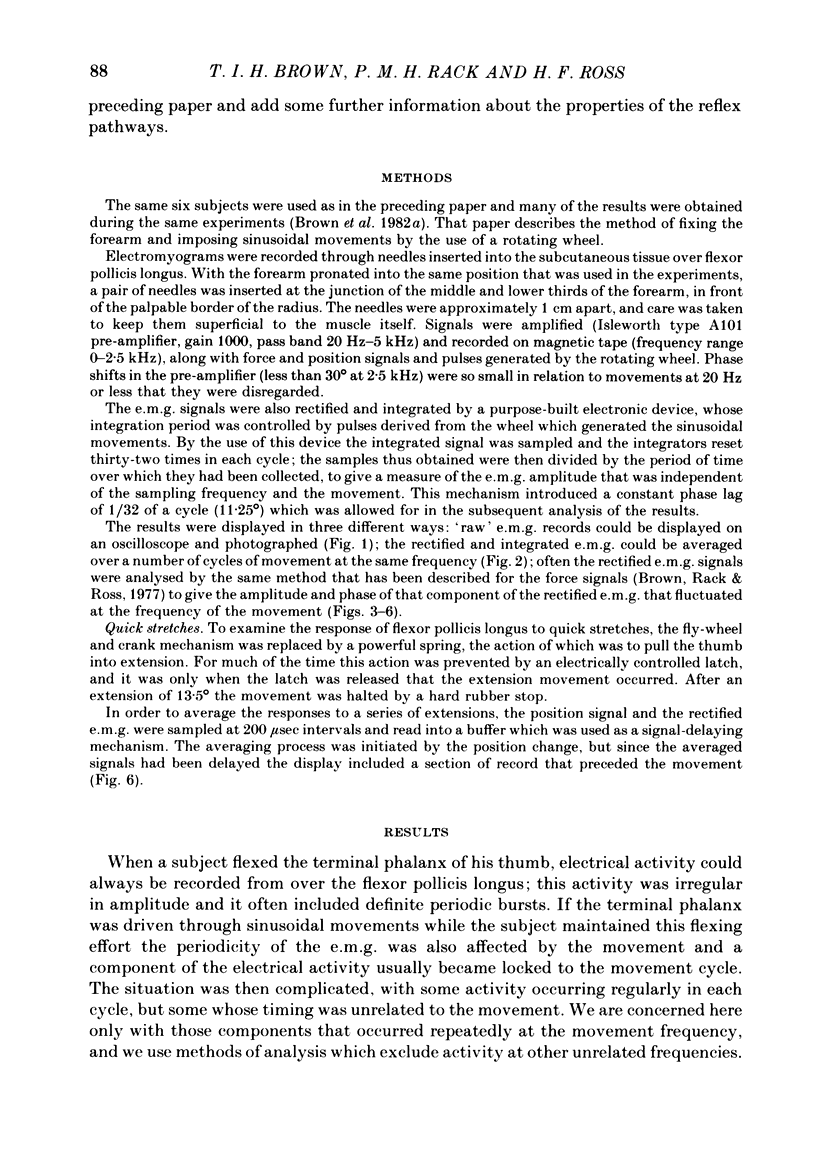

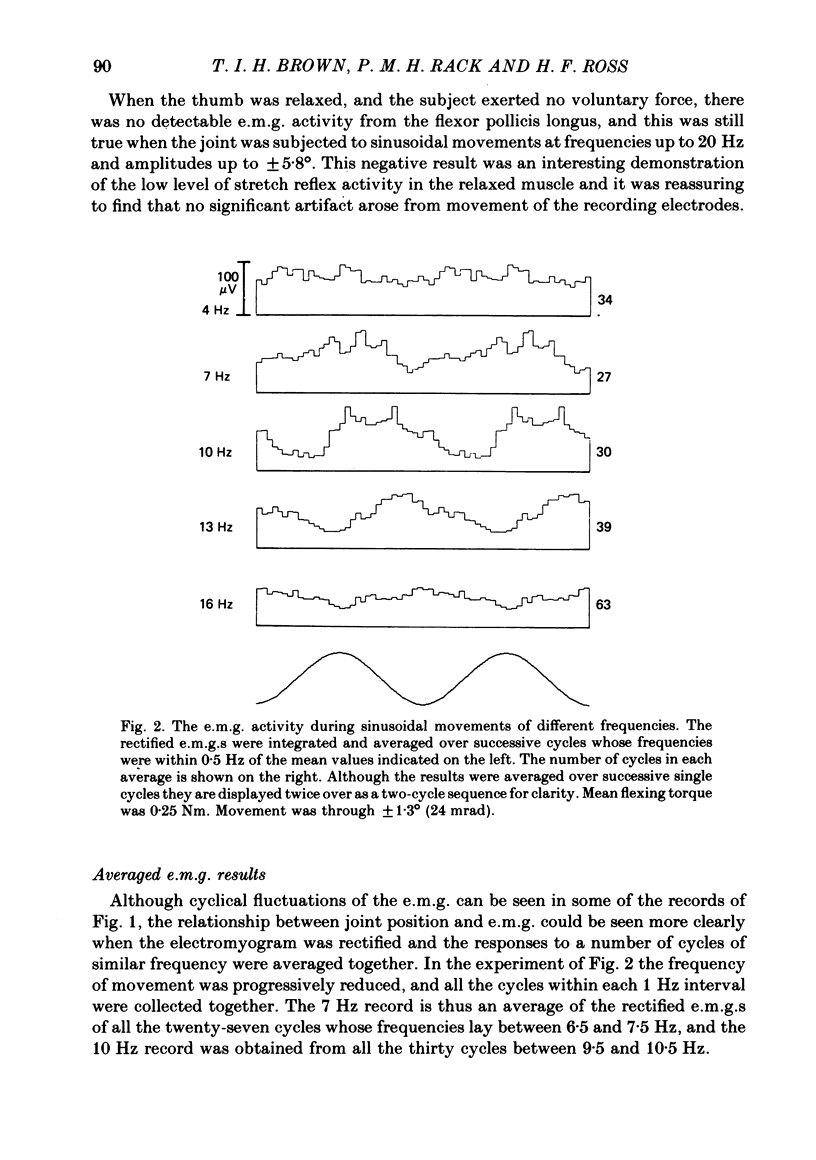

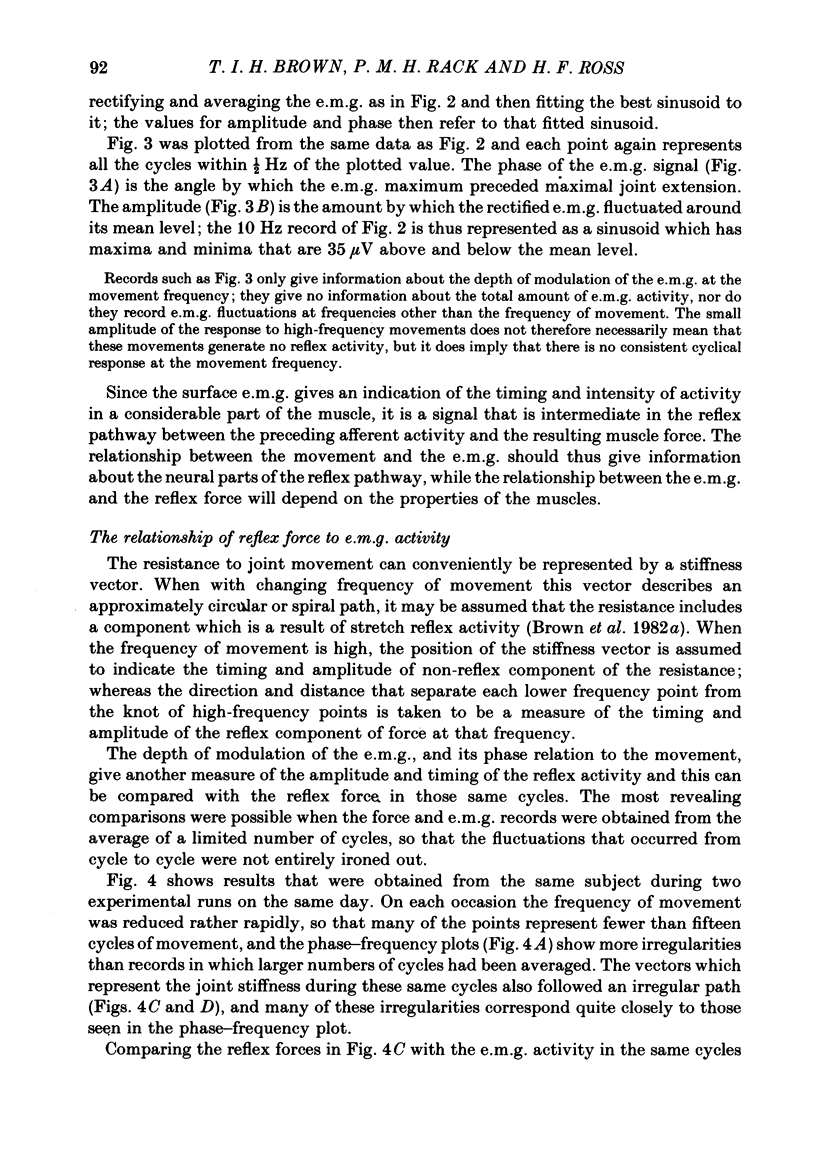

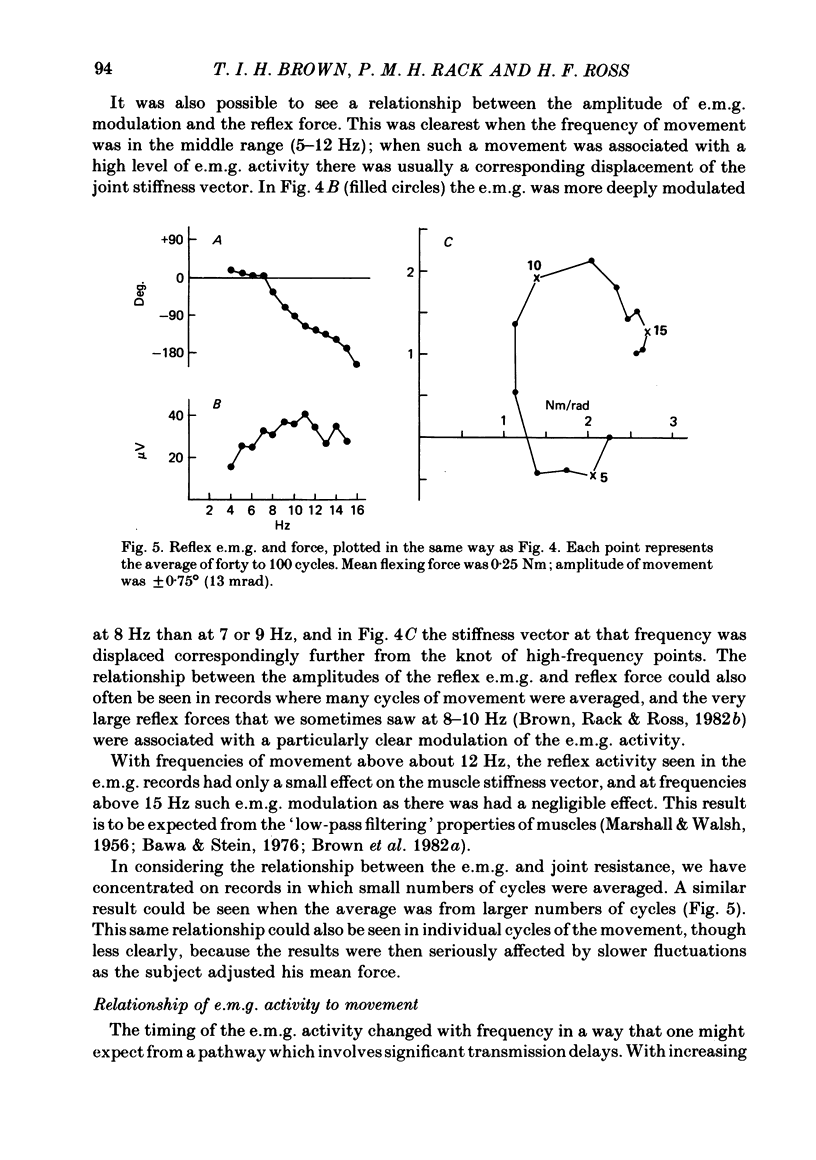

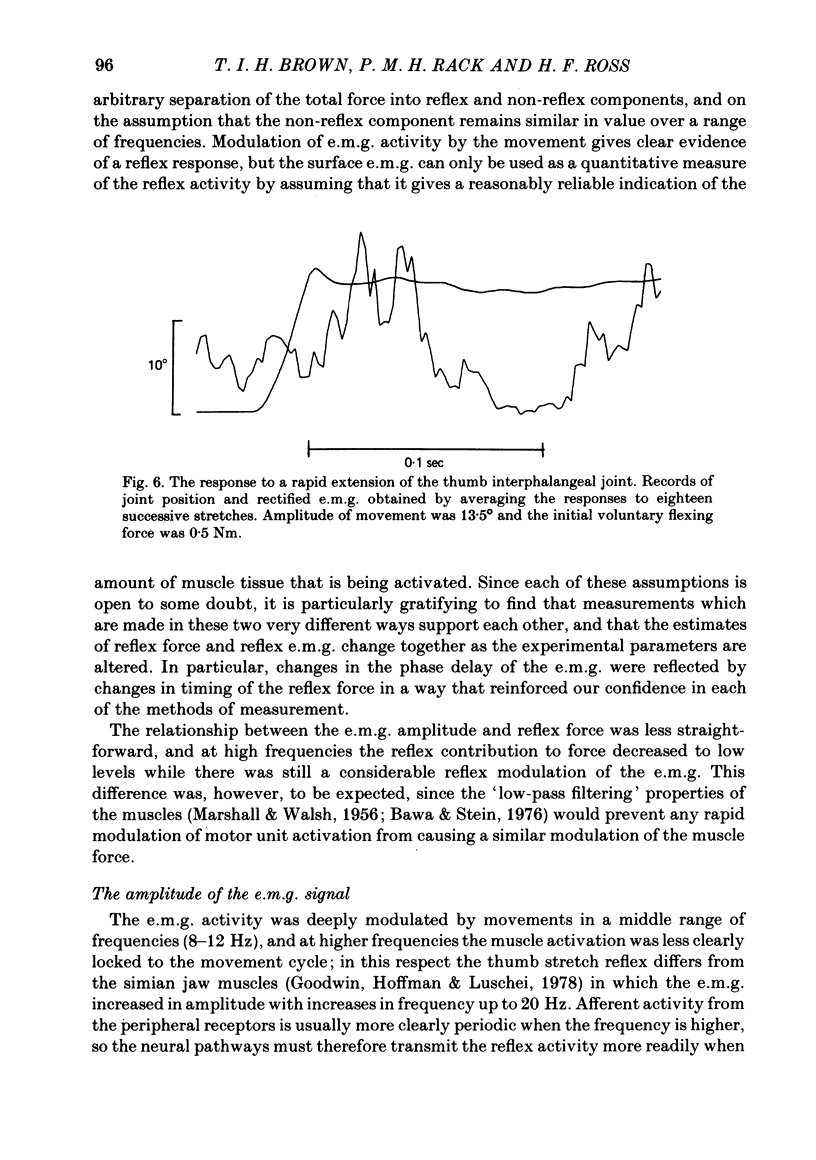


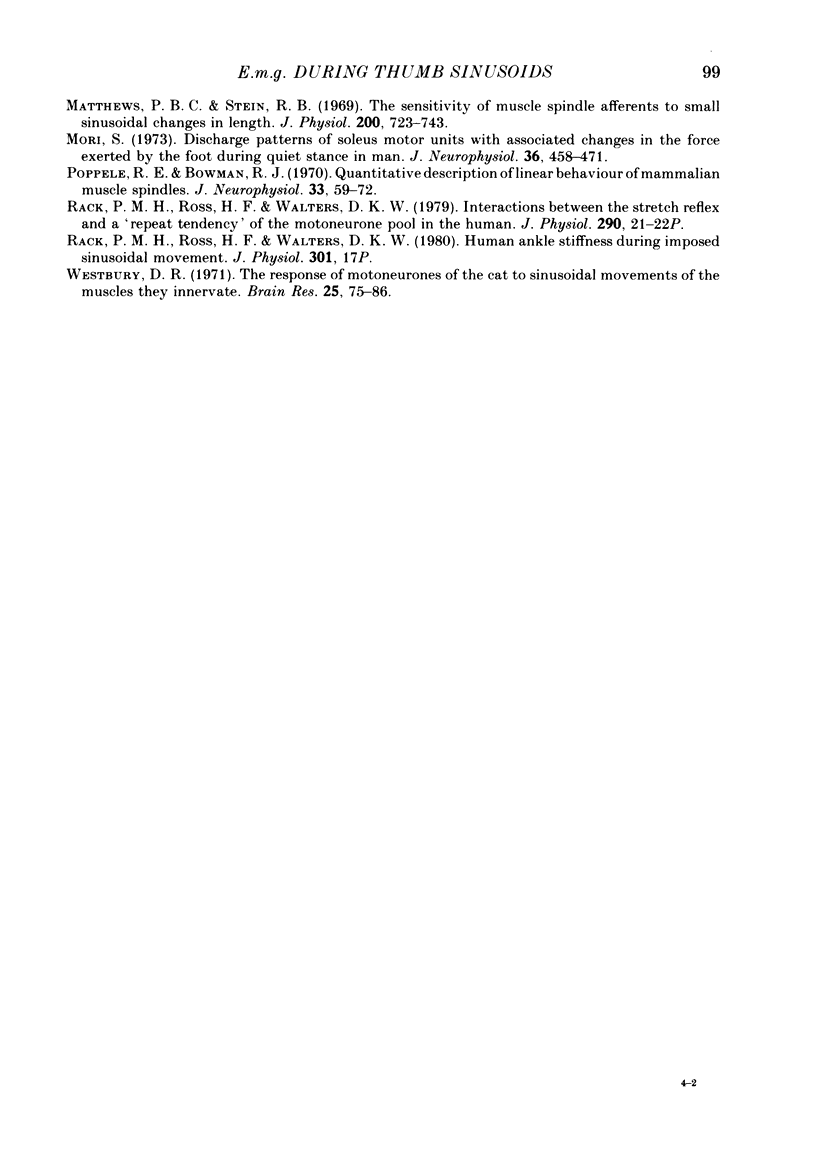
Selected References
These references are in PubMed. This may not be the complete list of references from this article.
- Agarwal G. C., Gottlieb G. L. Oscillation of the human ankle joint in response to applied sinusoidal torque on the foot. J Physiol. 1977 Jun;268(1):151–176. doi: 10.1113/jphysiol.1977.sp011852. [DOI] [PMC free article] [PubMed] [Google Scholar]
- Allum J. H., Dietz V., Freund H. J. Neuronal mechanisms underlying physiological tremor. J Neurophysiol. 1978 May;41(3):557–571. doi: 10.1152/jn.1978.41.3.557. [DOI] [PubMed] [Google Scholar]
- Bawa P., Stein R. B. Frequency response of human soleus muscle. J Neurophysiol. 1976 Jul;39(4):788–793. doi: 10.1152/jn.1976.39.4.788. [DOI] [PubMed] [Google Scholar]
- Brown T. I., Rack P. M., Ross H. F. A range of different stretch reflex responses in the human thumb. J Physiol. 1982 Nov;332:101–112. doi: 10.1113/jphysiol.1982.sp014403. [DOI] [PMC free article] [PubMed] [Google Scholar]
- Brown T. I., Rack P. M., Ross H. F. Forces generated at the thumb interphalangeal joint during imposed sinusoidal movements. J Physiol. 1982 Nov;332:69–85. doi: 10.1113/jphysiol.1982.sp014401. [DOI] [PMC free article] [PubMed] [Google Scholar]
- Brown T. I., Rack P. M., Ross H. F. The thumb stretch reflex [proceedings]. J Physiol. 1977 Jul;269(1):30P–31P. [PubMed] [Google Scholar]
- Freedman W., Herman R. Inhibition of electromyographic activity in human triceps surae muscles during sinusoidal rotation of the foot. J Neurol Neurosurg Psychiatry. 1975 Apr;38(4):336–345. doi: 10.1136/jnnp.38.4.336. [DOI] [PMC free article] [PubMed] [Google Scholar]
- Goodwin G. M., Hoffman D., Luschei E. S. The strength of the reflex response to sinusoidal stretch of monkey jaw closing muscles during voluntary contraction. J Physiol. 1978 Jun;279:81–111. doi: 10.1113/jphysiol.1978.sp012332. [DOI] [PMC free article] [PubMed] [Google Scholar]
- Jansen J. K., Rack P. M. The reflex response to sinusoidal stretching of soleus in the decerebrate cat. J Physiol. 1966 Mar;183(1):15–36. doi: 10.1113/jphysiol.1966.sp007849. [DOI] [PMC free article] [PubMed] [Google Scholar]
- MARSHALL J., WALSH E. G. Physiological tremor. J Neurol Neurosurg Psychiatry. 1956 Nov;19(4):260–267. doi: 10.1136/jnnp.19.4.260. [DOI] [PMC free article] [PubMed] [Google Scholar]
- Mannard A., Stein R. B. Determination of the frequency response of isometric soleus muscle in the cat using random nerve stimulation. J Physiol. 1973 Mar;229(2):275–296. doi: 10.1113/jphysiol.1973.sp010138. [DOI] [PMC free article] [PubMed] [Google Scholar]
- Matthews P. B., Stein R. B. The sensitivity of muscle spindle afferents to small sinusoidal changes of length. J Physiol. 1969 Feb;200(3):723–743. doi: 10.1113/jphysiol.1969.sp008719. [DOI] [PMC free article] [PubMed] [Google Scholar]
- Mori S. Discharge patterns of soleus motor units with associated changes in force exerted by foot during quiet stance in man. J Neurophysiol. 1973 May;36(3):458–471. doi: 10.1152/jn.1973.36.3.458. [DOI] [PubMed] [Google Scholar]
- Poppele R. E., Bowman R. J. Quantitative description of linear behavior of mammalian muscle spindles. J Neurophysiol. 1970 Jan;33(1):59–72. doi: 10.1152/jn.1970.33.1.59. [DOI] [PubMed] [Google Scholar]
- Rack P. M., Ross H. F., Walters D. K. Interactions between the stretch reflex and a 'repeat tendency' of the motoneurone pool in the human [proceedings]. J Physiol. 1979 May;290(2):21P–22P. [PubMed] [Google Scholar]
- Westbury D. R. The response of alpha-motoneurones of the cat to sinusoidal movements of the muscles they innervate. Brain Res. 1971 Jan 8;25(1):75–86. doi: 10.1016/0006-8993(71)90568-3. [DOI] [PubMed] [Google Scholar]


